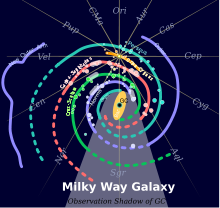Before we can properly calculate the forces which affect the system we are in, it is important to know where we are in relation to the universe.
Most of our gravity comes from the earth we live on. It is the largest force acting on us. We also have the gravity of the moon, which affects the tides. Then there is the sun, with its own gravity, and of course its own magnetic (electromagnetic) fields. The earth has a strong magnetic field, generated by the fact that we are spinning, one revolution (relative to the sun) every day.
The siun generates a magnetic forcr which acts away from itself, (at right angles to our north/south magnetic pole- more about this later) and of course we are inside a galaxy, and rotating around the galactic centre, in a plane which is roughly in line with the (apparent) rotation of the sun around our equator.
Our motion around the centre of the galaxy is probably the biggest contributor to our angular momentum, which in turn is probably the largest component to what we call gravity, because it is the largest local velocity relative to our nearest and biggest gravitational forces.
I'm not saying that without gravity I believe every atom would break away from every molecule, and every atom would break up because atoms and molecules are bound with chemical forces, and they exist in their own space, which means the motions inside them continue in a friction free environment, however it takes gravity, and mass to create these atoms and molecules in the first place.
Each spiral arm describes a logarithmic spiral (as do the arms of all spiral galaxies) with a pitch of approximately 12 degrees. Until recently, there were believed to be four major spiral arms which all start near the galaxy's center. These are named as follows, according to the image at right:
| Color | Arm(s) |
|---|---|
| cyan | 3-kpc and Perseus Arm |
| purple | Norma and Outer arm (Along with a newly discovered extension) |
| green | Scutum–Centaurus Arm |
| pink | Carina–Sagittarius Arm |
| There are at least two smaller arms or spurs, including: | |
| orange | Orion–Cygnus Arm (which contains the Sun and Solar System |
In the general sense, the absolute velocity of any object through space is not a meaningful question according to Einstein's special theory of relativity, which declares that there is no "preferred" inertial frame of reference in space with which to compare the object's motion. (Motion must always be specified with respect to another object.) This must be kept in mind when discussing the galaxy's motion.
General relativity or the general theory of relativity is the geometric theory of gravitation published by Albert Einstein in 1916.[1] It is the current description of gravitation in modern physics. General relativity generalises special relativity and Newton's law of universal gravitation, providing a unified description of gravity as a geometric property of space and time, or spacetime. In particular, the curvature of spacetime is directly related to the four-momentum (mass-energy and linear momentum) of whatever matter and radiation are present. The relation is specified by the Einstein field equations, a system of partial differential equations.

Image of the Milky Way's Galactic Center in the night sky above Paranal Observatory
In relativity theory, proper acceleration[1] is the physical acceleration (i.e., measurable acceleration as by an accelerometer) experienced by an object. It is acceleration relative to a free-fall, or inertial, observer who is momentarily at rest relative to the object being measured. This contrasts with coordinate acceleration, which is dependent on choice of coordinate systems and thus upon choice of observers.

the speed of light = 299, 792, 458 m / s
Galaxy rotation curve for the Milky Way. Vertical axis is speed of rotation about the Galactic Center. Horizontal axis is distance from the Galactic Center in kpcs. The sun is marked with a yellow ball. The observed curve of speed of rotation is blue. The predicted curve based upon stellar mass and gas in the Milky Way is red. Scatter in observations roughly indicated by gray bars. The difference is due to dark matter or perhaps a modification of the law of gravity.[78][79][80]
The three different classes of standard tori correspond to the three possible relative sizes of r and R. When R > r, the surface will be the familiar ring torus. The case R = r corresponds to the horn torus, which in effect is a torus with no "hole". The case R < r describes the self-intersecting spindle torus. When R = 0, the torus degenerates to the sphere.

Ring torus

Horn torus

Spindle torus
In physics, acceleration is the rate of change of velocity with time.[1] In one dimension, acceleration is the rate at which something speeds up or slows down. However, since velocity is a vector, acceleration describes the rate of change of both the magnitude and the direction of velocity.[2][3] Acceleration has the dimensions L T −2. In SI units, acceleration is measured in meters per second squared (m/s2). (Negative acceleration i.e. retardation, also has the same dimensions/units.)
Proper acceleration, the acceleration of a body relative to a free-fall condition, is measured by an instrument called an accelerometer.
In common speech, the term acceleration is used for an increase in speed (the magnitude of velocity); a decrease in speed is called deceleration. In physics, a change in the direction of velocity also is an acceleration: for rotary motion, the change in direction of velocity results in centripetal (toward the center) acceleration; whereas the rate of change of speed is a tangential acceleration.
In classical mechanics, for a body with constant mass, the acceleration of the body is proportional to the net force acting on it (Newton's second law):
where F is the resultant force acting on the body, m is the mass of the body, and a is its acceleration.
